Content AI allows you to set the tone, language, choose your target audience & more every time you use the AI tool.
But wouldn’t it be time-consuming to set them for each prompt?
Thankfully, Rank Math includes a dedicated section to let you configure the Global Settings for Content AI, so by default, all your prompts will use these configurations unless you want to change them.
Content AI Global Settings
To access the Content AI Global settings, head over to Rank Math SEO → General Settings → Content AI in your WordPress dashboard, as shown below.
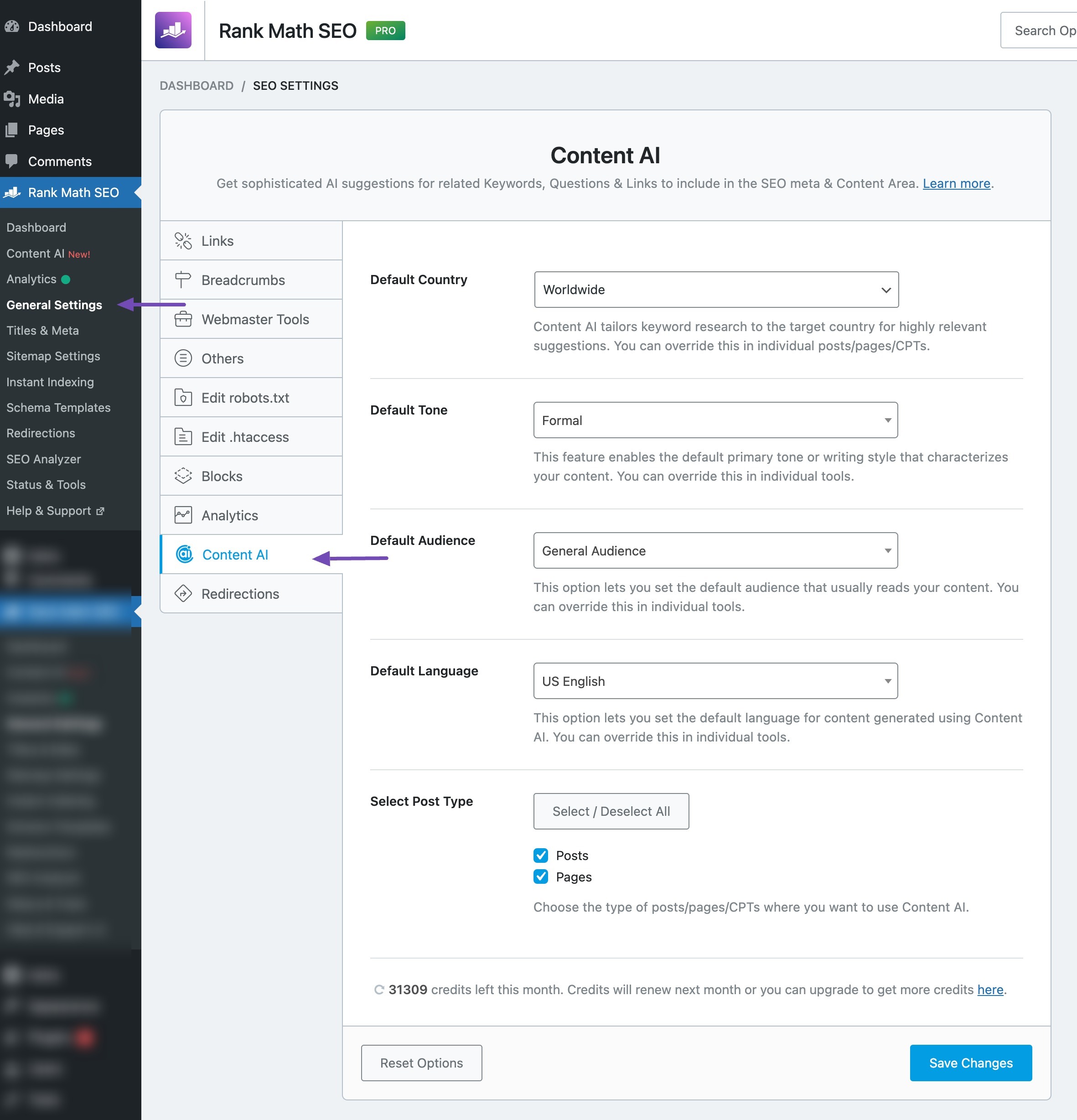
If these settings are unavailable for you, then check if you have enabled the Content AI module under WordPress Dashboard → Rank Math SEO → Dashboard → Modules → Content AI.

Now, let us discuss each of these options one by one.
1 Default Country
Here, you can choose the default country that you want to target. If you’re targeting a Global Audience, then choose Worldwide.
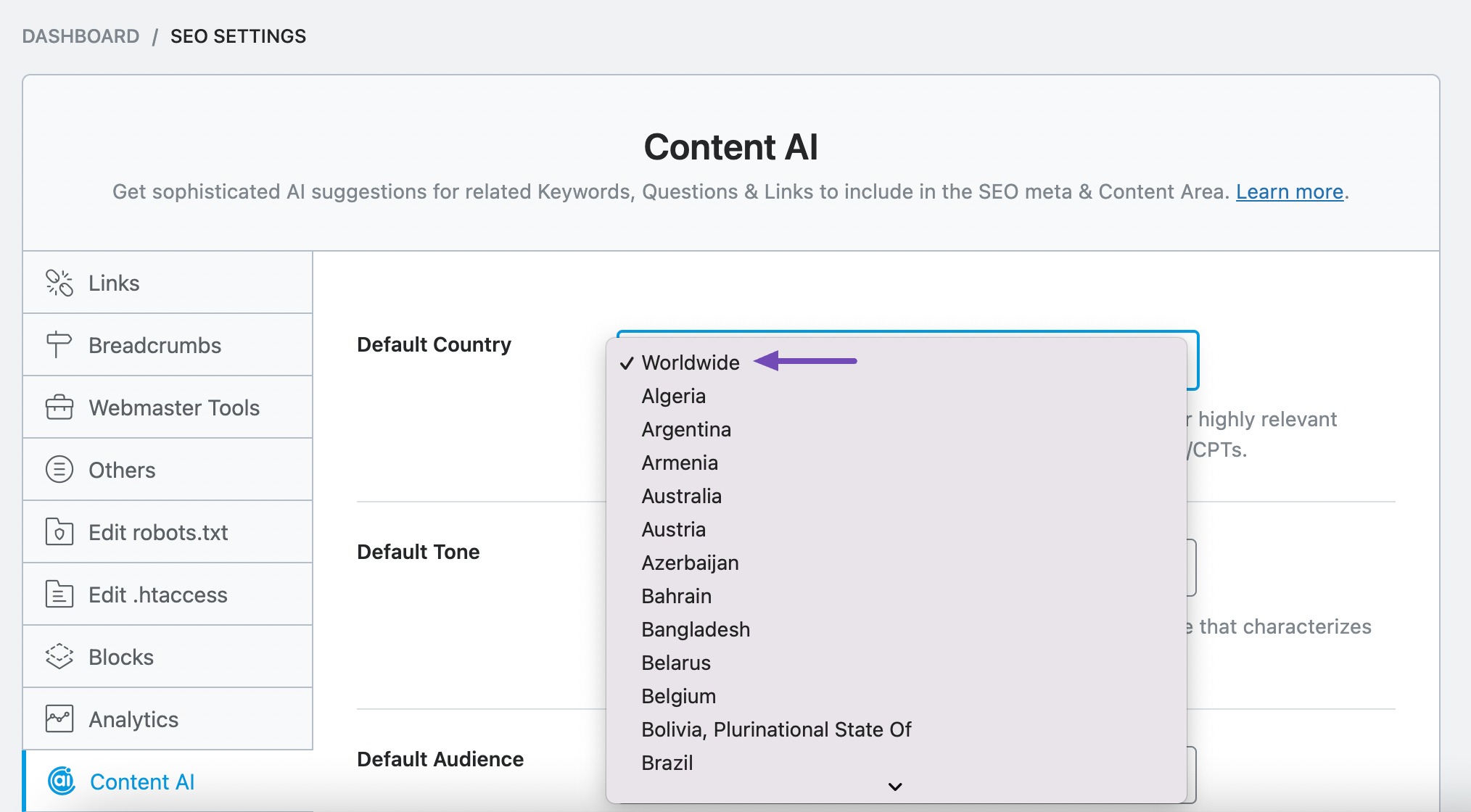
Here is a complete list of the country options that are available to select.
| Worldwide | Ghana | Paraguay |
| Algeria | Greece | Peru |
| Argentina | Guatemala | Philippines |
| Armenia | Hong Kong | Poland |
| Australia | Hungary | Portugal |
| Austria | India | Romania |
| Azerbaijan | Indonesia | Russian Federation |
| Bahrain | Ireland | Saudi Arabia |
| Bangladesh | Israel | Senegal |
| Belarus | Italy | Serbia |
| Belgium | Japan | Singapore |
| Bolivia, Plurinational State Of | Jordan | Slovakia |
| Brazil | Kazakhstan | Slovenia |
| Bulgaria | Kenya | South Africa |
| Cambodia | Korea, Republic Of | Spain |
| Canada | Latvia | Sri Lanka |
| Chile | Lithuania | Sweden |
| Colombia | Macedonia, The Former Yugoslav Republic Of | Switzerland |
| Costa Rica | Malaysia | Taiwan |
| Croatia | Malta | Thailand |
| Cyprus | Mexico | Tunisia |
| Czechia | Morocco | Turkey |
| Denmark | Myanmar | Ukraine |
| Ecuador | Netherlands | United Arab Emirates |
| Egypt | New Zealand | United Kingdom |
| El Salvador | Nicaragua | United States Of America |
| Estonia | Nigeria | Uruguay |
| Finland | Norway | Venezuela, The Bolivarian Republic Of |
| France | Pakistan | Viet Nam |
| Germany |
2 Default Tone
By default, Content AI’s tone is set to formal. If you prefer to change the default tone in which Content AI generates its output, click the dropdown to select your preferred tone. The selected tone will be the default tone for all Content AI outputs, including outputs generated by the AI Assistant block.
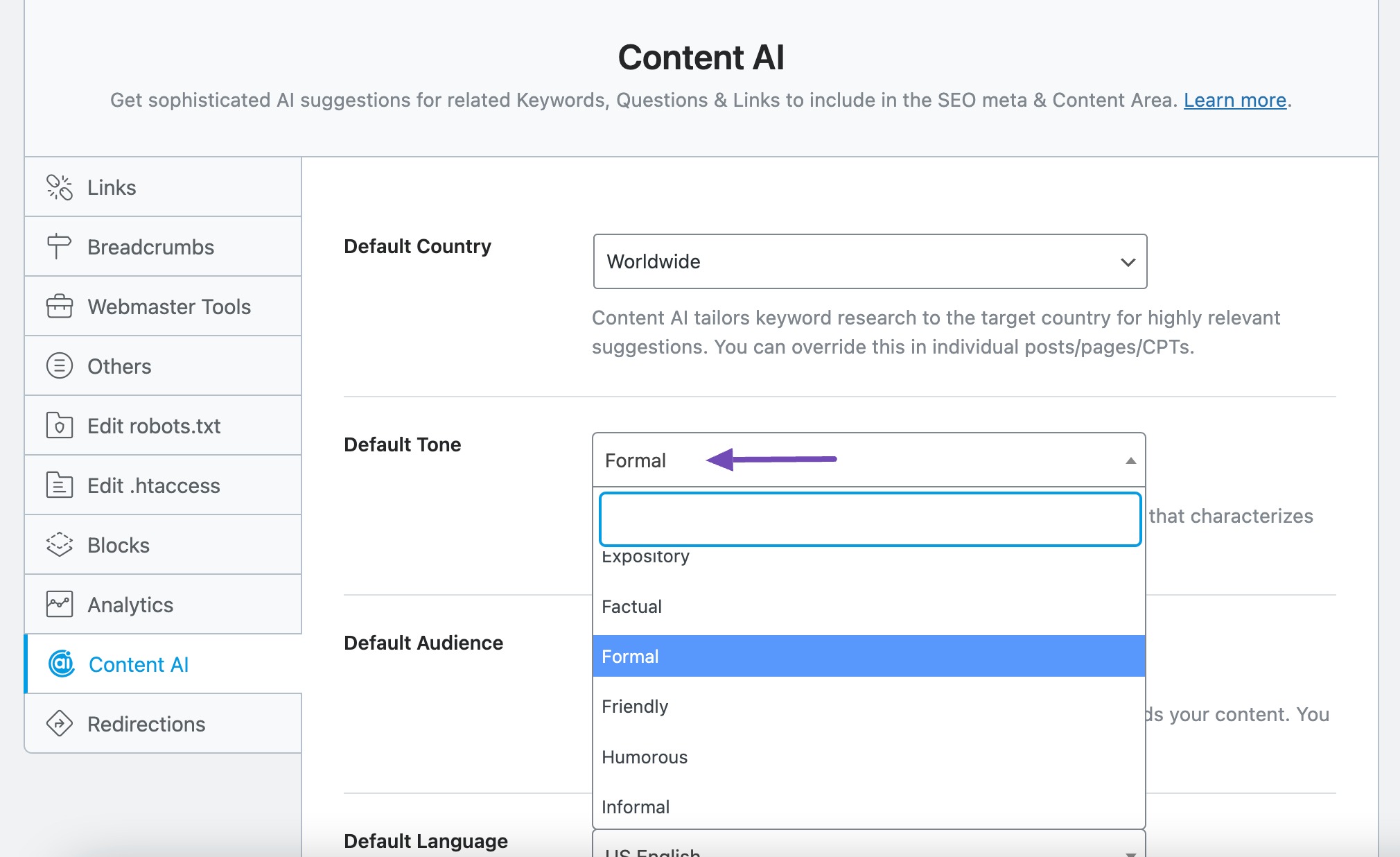
While these tones are self-explanatory, we’ve explained each one of them in detail below to differentiate them better.
Formal
A high degree of formality and professionalism, often used in business or academic writing.
Informal
A casual and relaxed tone is often used in personal writing or social media.
Friendly
Focuses on establishing a positive connection with the readers using a casual and conversational style.
Casual
A more conversational tone is often used in social media or in blog posts.
Conversational
Focuses on a back-and-forth dialogue, often used in customer service or support contexts
Descriptive
Focuses on detailed descriptions, often used in product descriptions or travel guides.
Persuasive
Focusing on convincing the reader or listener to take a specific action is often used in sales or advertising.
Technical
Focuses on technical details, and precision, which is often used in software documentation or scientific research.
Analytical
This style involves analyzing and evaluating information or arguments and often presents a critical perspective.
Journalese
A style commonly used in news reporting and journalism
Poetic
Focuses on imagination, which is often used in poetry or fiction.
Factual
An emphasis on accuracy and the presentation of factual information is often used in news articles or scientific papers.
Emotional
Use of anecdotes, relatable experiences, and storytelling techniques to create emotional resonance and establish a connection with the audience.
Satirical
The use of irony, wit, and sarcasm to criticize or mock a subject is often used in comedy or satirical writing.
Empathetic
Exhibits the writer’s effort to understand and communicate with the reader or listener, which is often used in counseling or customer service contexts.
Opinionated
The inclusion of personal opinions and viewpoints is often used in opinion pieces or editorial articles.
Humorous
The use of jokes, puns, and other forms of comedy, often used in stand-up or comedic writing.
Story-telling
The use of narrative techniques to tell a story is often used in fiction or non-fiction writing.
Narrative
Uses a descriptive and engaging style to captivate the reader’s attention.
Expository
The tone is used for presenting facts, evidence, and logical explanations in a clear and organized manner.
Argumentative
The tone used in persuasive speech, opinion pieces, and debates to present a particular viewpoint/opinion with the intent to convince readers.
Objective
The tone used in presenting the topic without any personal bias or emotions.
Subjective
Use of descriptive language, anecdotes, and emotional expressions to engage with the reader on a more personal level.
3 Default Audience
This dropdown lets you choose your default audience. Though we have a comprehensive list, we understand it isn’t always possible to define your target audience within this classification. Hence, our AI tool lets you define your custom audience in the prompt.
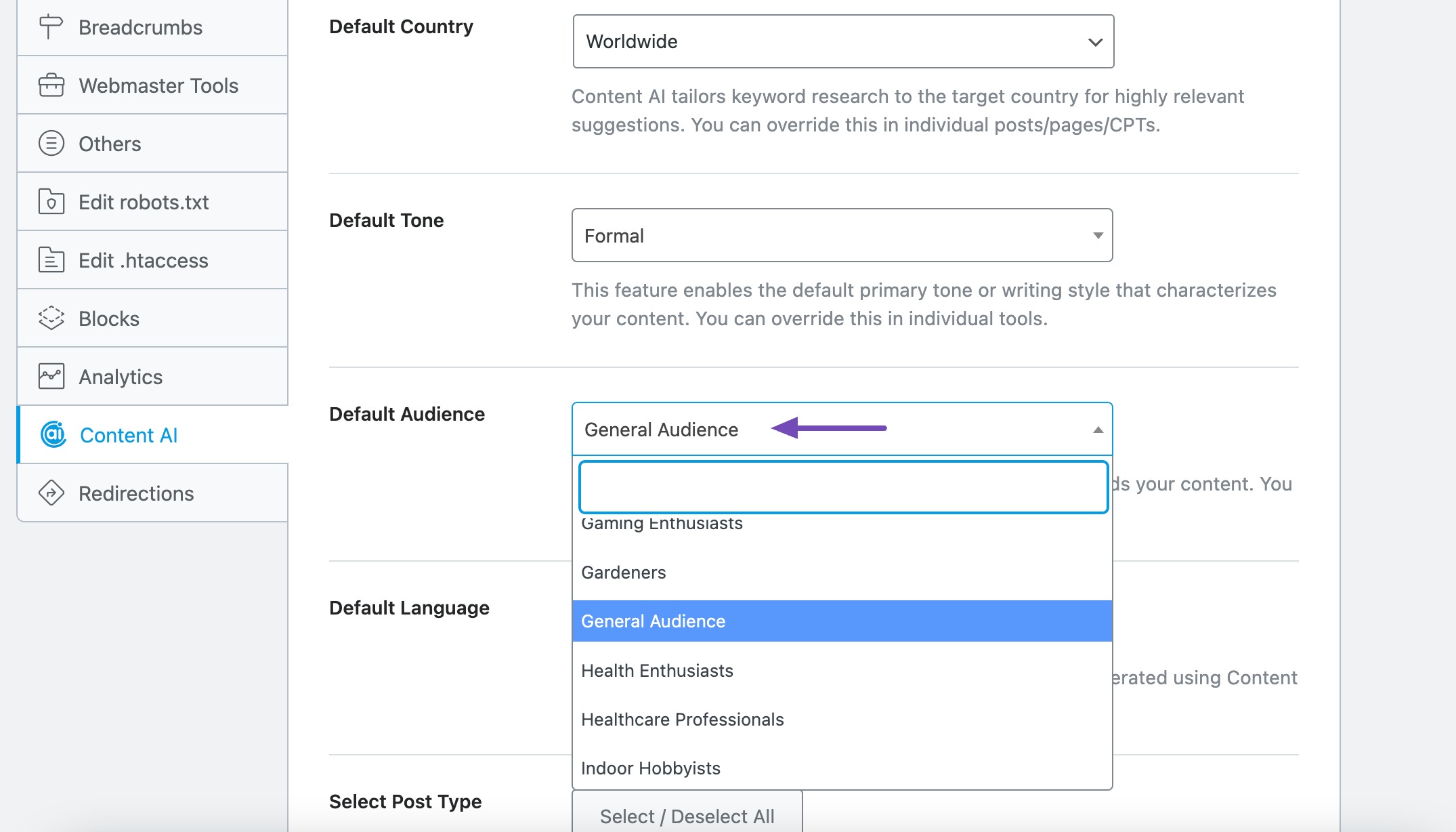
Similarly, this list is only the default configuration; you can always override it with the prompt for our AI tools.
Here is the comprehensive list of default audiences to choose from.
| General Audience | Consumers | Students |
| Professionals | Business Owners | Job Seekers |
| Investors | Entrepreneurs | Social Media Users |
| Travelers | Pet Owners | Seniors |
| Gaming Enthusiasts | Environmentalists | Sports Fans |
| Health Enthusiasts | Tech Enthusiasts | Parents |
| Artists | Musicians | Photographers |
| Writers | Retirees | Healthcare Professionals |
| Educators | Activists | Foodies |
| Cooks | Fitness Enthusiasts | Bargain Hunters |
| Fashionists | Outdoor Enthusiasts | Indoor Hobbyists |
| Gardeners | DIYers | Crafters |
| Collectors | Dancers | Gamers |
| Movie Buffs | TV Enthusiasts | Movie Creators |
| Engineers | Designers | Podcast Listeners |
| Bloggers | Authors |
4 Default Language
In this field, you can select the default language in which Content AI should generate the output. The selected language will be the default for all Content AI outputs, including the ones generated by the AI Assistant block.
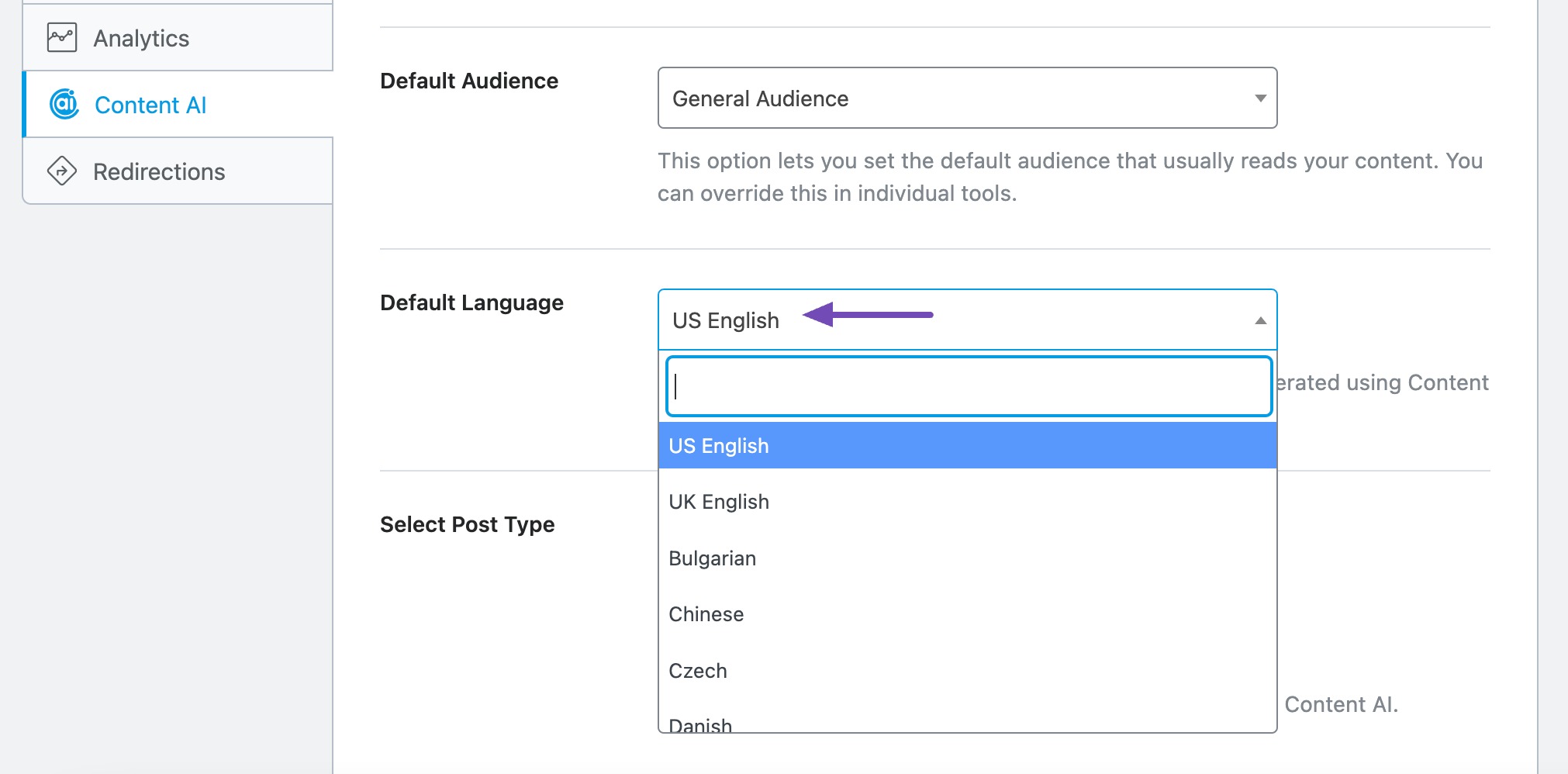
Here is the complete list of languages that Content AI supports as of now.
| US English | UK English | Bulgarian |
| Chinese | Czech | Danish |
| Dutch | Estonian | Finnish |
| French | German | Greek |
| Hebrew | Hungarian | Indonesian |
| Italian | Japanese | Korean |
| Latvian | Lithuanian | Norwegian |
| Polish | Portuguese | Romanian |
| Russian | Slovak | Slovenian |
| Spanish | Swedish | Turkish |
5 Select Post Type
This option allows you to select the post types where you prefer to use Content AI.
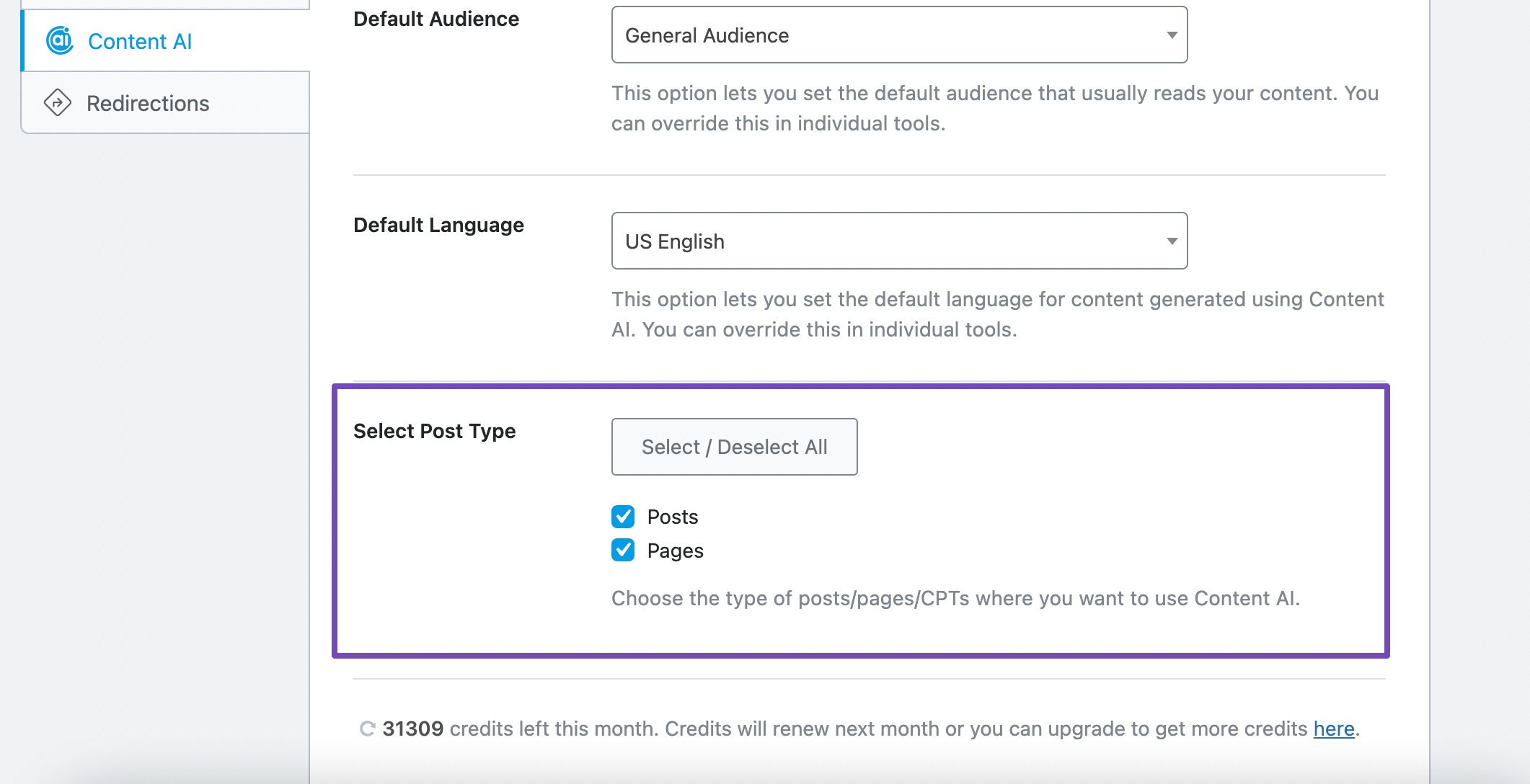
6 Refresh Content AI Credits
At the bottom of the settings, you’ll notice the number of Content AI credits available with your account. You may also click the refresh button to check the updated count.
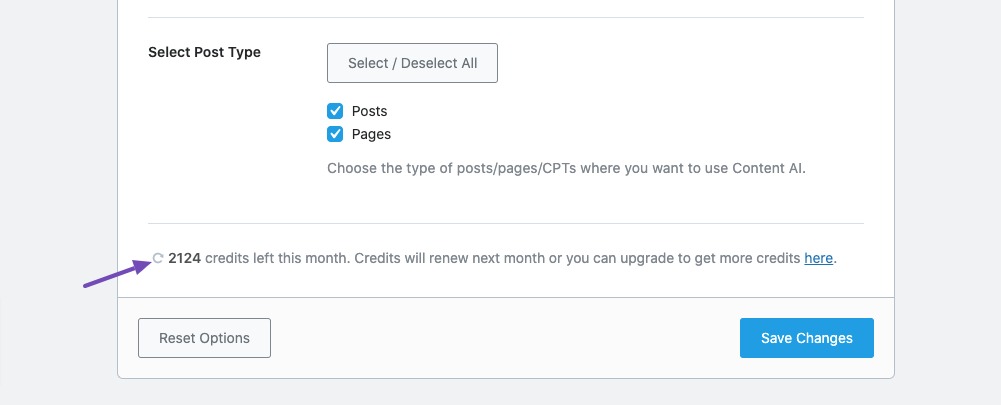
Once you’re done with configuring your Content AI Global settings, click the Save Changes button at the bottom of the page for the changes to reflect.

And that’s it! We hope the article helped you configure the Global Settings so Content AI can swiftly write for your tailored requirements. If you have any questions or need help configuring Content AI for your website, please open a support ticket here, and our support team will be more than happy to assist you.